Visit Halong Bay, Vietnam

Watching the islands of Halong Bay pass by from the deck of a junk, a refreshing drink in hand, is one of the most relaxing ways to explore. As the sun sets, the surrounding boats are silhouetted along the horizon and the sky turns coral pink.
Local legend tells of Vietnamese gods sending Mother Dragon and her children down to Earth to help the people defend their country. The dragons carved large valleys and gorges with their tails. These then flooded, creating Halong Bay, translated as "descending dragon". Watching the limestone pillars jut out of the early morning mist, it’s easy to appreciate that this otherworldly seascape has a mystical importance to the Vietnamese people.
The sheer columns of rock have gradually eroded to create a network of caves, grottos and arches, which are best explored by boat. Due to their precipitous nature, most are uninhabited — topped with tangled patches of jungle and occasionally fringed by narrow beach. Local life clings to the water, where people live in brightly painted floating villages.
Things to see and do in Halong Bay
Embark on a cruise on board a traditional Vietnamese junk
Junks were originally Chinese sailing boats, introduced to Vietnam during the 14th century. They have since become an important part of Vietnamese culture, used for transporting goods and people along the coast. Many of these traditional vessels have been converted into comfortable passenger boats, running one or two night cruises.
From the junk you can take to the water and navigate the islands by kayak to reach less visited bays and concealed caves. On board, you can enjoy freshly cooked muc rang muoi (spice squid), cari ga (chicken curry) and cocktails at sunset on the polished top deck. Boat sizes vary from 10- to 24-cabin vessels. For a more intimate experience, private boats are also available.
Visit quieter Bai Tu Long Bay
If you extend the time spent on board your junk to two nights, it’s possible to explore more of Vietnam’s coastline. Bai Tu Long Bay is 30 km (19 miles) east of Halong Bay. At first glance, the two bays look very similar, with greenery-covered limestone karsts poking out of a deep green sea. On closer inspection, you’ll find that Bai Tu Long receives far fewer boats, resulting in a more peaceful atmosphere.
Rise to watch the sunrise and join a t'ai chi class on deck
One of the benefits of staying on board a junk in Halong Bay is the chance to be on the water as the sun rises. It’s worth emerging early from your cabin — the crew will often have tea and coffee waiting — to see the peach-pink sky reflected by the limestone.
Many junks offer an early morning t'ai chi class, held up on deck. An experienced teacher instructs you in a series of relaxing, gentle movements accompanied by the sounds of waves lapping against the boat’s hull.
Hike up the many stairs to the lookout point on Ti Top Island
Most photographs of Halong Bay are taken from the water, but the top of Ti Top Island offers a different viewpoint. You can hike up to the summit of the island, which is named after Russian astronaut Gherman Titov (who relaxed on the Island during an official visit) to smooth relations with the Soviet Union in the 60s.
Lying southeast of Bai Chay Harbour in the west of Halong Bay, the island is a jungle-covered wedge of rock with a flight of steps leading right to its peak. Here you’ll find a wooden viewing platform from where you can take in views right across the bay. After the steep climb and descent, you can relax on the island’s small crescent beach. If you arrive in late afternoon, the small beachside bar tucked under the cliff might be open for a cocktail.
Best time to visit Halong Bay
It’s possible to visit Halong Bay year round, each season creating a markedly different atmosphere. March through to November tends to be the best time to visit, with April boasting the clearest skies and least rain — although the occasional shower still occurs. Visit in January or February and you’ll find it cool and wet but the ensuing fog can be incredibly atmospheric.

.png)
.png)
- One of Halong Bay’s outlying islands, Quan Lan holds an annual festival to commemorate a historic victory against Mongol invaders in the 13th century. During the two-week celebrations, usually held in June, villagers aren’t allowed to leave the island — but guests are warmly welcomed. The festival culminates in a traditional rowing competition across the bay.
- Held in Halong City in April, the Carnaval Halong dances its way through the streets. Showcasing a bright array of traditional costumes, performers travel from across Vietnam to join in, as well as persuading many watching locals and visitors to join in the party.
- Vietnamese New Year, known as Tết, is the country’s most important festival of the year, usually falling in late January or February. It’s celebrated across the whole of Vietnam with towns, cities and even boats decorated yellow and red to signify good luck






